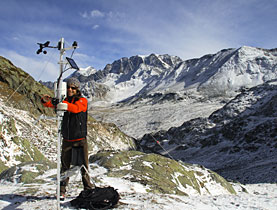
Alps get high-tech environmental monitoring

Swiss scientists are working on a new way to better predict floods, landslides and avalanches – among the most feared consequences of climate change in the Alps.
Swiss Experiment uses cutting edge wireless sensor network technology to collect up-to-the-minute data from the mountainside to gain a clearer idea of what is going on there.
Among those involved is Karl Aberer, a professor at the Swiss Federal Institute of Technology in Lausanne. He deals with the information technology side of the project, which also includes environmental engineers from several Swiss institutes as well as computing giant Microsoft.
Global warming in the Alps is already happening, Aberer told a recent Internet of Things conference in Zurich, where he was presenting Swiss Experiment.
Glaciers are shrinking, and flooding can have devastating effects. The village of Poschiavo in eastern Switzerland was destroyed by a torrent of water in 1987.
At present there is limited capacity for gathering and analysing detailed data from the mountains. Some sites are simply too remote or too difficult to access. The alpine environment is also very variable.
Until now field sites and satellites have been used, but Swiss Experiment believes that it has come up with something better – wireless sensor networks.
“By using [these networks] environmental engineers can now measure at many different points at the same time so they get a more detailed picture of what is happening over a larger region,” Aberer told swissinfo.
Sensors placed
This basically means that sensors are placed – or even helicoptered in – at different points all over, for example, a rock glacier like Le Génépi in the Valais mountains. This form of glacier is dangerous because melting could result in a rock fall.
Scientists do not yet understand fully how the wind, temperature, ice and topography of the terrain interact on rock glaciers. The sensors send information about these things back to researchers who then feed it into environmental models and analyse it.
Aberer, also director of the Swiss National Competence Centre for Mobile Information and Communications Systems, has been helping to develop the wireless sensor networks, a technology that is only around a decade old.
The Swiss Experiment project, which was officially launched last November, is one of its first practical applications so far.
“The sensor stations communicate through wireless links, they have a very low energy consumption so they can operate for a long time.
“And they are relatively easy to deploy because in such harsh environments there is no time or opportunity to test the equipment or fix problems,” he explained.
Real-time information
The big advantage is that information is sent back in real time – previously data was physically collected from field stations and read later.
This helps in monitoring and adapting the experiment in real time and will eventually also help predict events such as rock fall or floods.
Snow is also an issue. “We are working with the Avalanche Institute in Davos which wants to understand how snow is deposited and how avalanches are generated as a result,” Aberer said.
Once collected, the data needs to be stored. An IT infrastructure has been created to manage and analyse the collected information, which is accessible to the whole scientific community.
“That’s one of the major obstacles: many works happen in isolation and the data and tools are not really shared among scientists,” said Aberer.
Unique project
The professor says the project is unique in its scale of coverage and scope of technology used.
It is also one of few projects worldwide chosen for support by Technical Computing at Microsoft Research.
The company wants to develop a Web-based 3D visualisation tool, similar to Google Earth. SensorMap will be used to publish and search for real-time sensor data – a goal being to help “researchers address some of the toughest environmental issues facing the world today”.
Aberer says in the long term Swiss Experiment could be extremely valuable for Switzerland considering the potential economic and social impact of climate change.
“I expect the benefits to be huge but of course, the future will have to prove this statement,” he said.
swissinfo, Isobel Leybold-Johnson in Zurich
Swiss Experiment was launched on November 23, 2007.
Participating institutions include the two Federal Institutes of Technology in Lausanne and Zurich, the Competence Centre Environment and Sustainability (CCES), the National Centre of Competence in Research Mobile Information and Communication Systems (NCCR-MICS) and the Swiss Federal Institute of Aquatic Science and Technology (EAWAG).
Also involved are the Federal Institute for Forest, Snow and Landscape Research (WSL/SLF), the Swiss National Science Foundation (SNF) and the Microsoft Corporation.
It aims to inform and involve the local populations near experiment sites, including through educational programmes, and by collaborating closely with local authorities.
The meeting, which ran from March 26-28, was organised by the Federal Institute of technology in Zurich, the Auto-ID Labs at St Gallen University, and MIT in the United States.
It was aimed at showcasing projects that connect the real and virtual worlds, i.e. the internet to machines.
In the Swiss Experiment the internet interacts directly with the environment, so not an artificial “thing” but a natural “thing”.

In compliance with the JTI standards
More: SWI swissinfo.ch certified by the Journalism Trust Initiative
















![The four-metre-long painting "Sonntag der Bergbauern" [Sunday of the Mountain Farmers, 1923-24/26] had to be removed by a crane from the German Chancellery in Berlin for the exhibition in Bern.](https://www.swissinfo.ch/content/wp-content/uploads/sites/13/2025/12/01_Pressebild_KirchnerxKirchner.jpg?ver=cb688ed5)















You can find an overview of ongoing debates with our journalists here . Please join us!
If you want to start a conversation about a topic raised in this article or want to report factual errors, email us at english@swissinfo.ch.